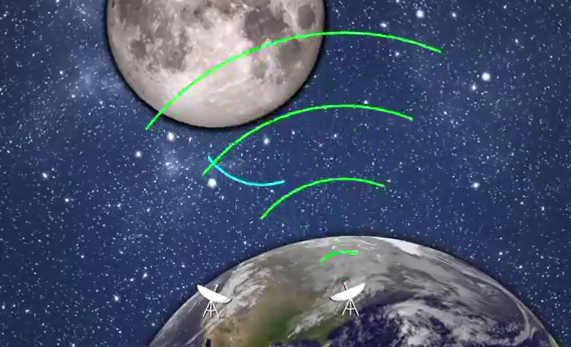(单词翻译:单击)
If you're trying to communicate with someone on the other side of the world,
如果你想和世界另一端的人交流,
say, on a navy ship positioned near an enemy country, satellites are pretty much the best way to do it.
比方说,在靠近敌国的海军舰艇上这样做,卫星是最好的方法。
But before the US launched its first satellite in January 1958, more than a decade into the Cold War,
但美国在1958年1月发射第一颗卫星之前,冷战已经持续了十多年,
the military tried out a few...more creative solutions.
于是军方尝试了一些……更有创造性的解决方案。
Including bouncing radio waves off of Earth's natural satellite...the Moon.
其中包括从地球的天然卫星——月球上反射无线电波。
After World War II, the U.S. was in a political standoff with the Soviet Union,
二战后,美国与苏联陷入政治僵局,
a country halfway around the world, which created all kinds of new communications challenges.
苏联横跨半个地球,这创造了各种各样的通讯新挑战。
American and allied ships could be almost anywhere,
美国和盟军的军舰几乎无处不在,
so the U.S. Navy needed a global communications system that was reliable and couldn't be easily intercepted.
所以美国海军需要一个可靠、无法被轻易拦截的全球通信系统。
Today, there are more than a thousand active satellites orbiting the Earth, and most are used for communication.
如今,一千多种主动人造卫星环绕地球旋转,大多数用于通信。
But back in the 1950s,
但在20世纪50年代,
the main technology involved bouncing high-frequency radio waves off a layer of the Earth's atmosphere called the ionosphere,
主要技术是把高频无线电波反射到地球大气层中的电离层,
which stretches from about 50-1000 km above the earth's surface.
电离层从离地面50千米处延伸至1000千米处。
The problem is, the ionosphere isn't a very reliable way to boost signals,
但问题是,电离层不是加强信号的可靠手段,
because it's constantly being hit by radiation from the sun and other objects in the galaxy,
因为它经常受到自太阳和银河系其他天体的辐射影响,
which can sometimes cause a lot of interference.
有时会引起很多干扰。
A poorly-timed solar storm, for example, could knock out global communication in the middle of a crisis,
比如,一个不合时宜的太阳风暴可能会导致危机中的全球通信中断,
which is pretty much an admiral's worst nightmare.
这会是舰队司令最可怕的梦魇。
Another problem was that it was hard to figure out where the Soviet Union had its radar stations and what they were capable of.
另一个问题是很难弄清楚苏联雷达站的位置和能力。
In case the U.S. ever launched an attack, which, thankfully, it never did,
如果美国发动了袭击,谢天谢地,它从来没有发动过,
those radar stations would detect the incoming bombers and missiles before they could strike.
这些雷达站将在它们侵袭前探测到即将到来的轰炸机和导弹。
And radar waves are so short that they can pass right through the ionosphere and into space,
而且雷达波非常短,它们可以穿过电离层进入太空,
so the US military couldn't detect them as well as other kinds of waves.
因此,美国军方无法像探测其他电波一样探测到它。
The only real way to map those stations was to fly over them, a mission so risky, the military stopped doing it after 1960.
唯一能绘制这些站点的方法就是飞到它们上空,这个任务很危险,军方在1960年后就禁止了。

The Navy thought they might be able to solve this problem by using the Moon to pick up Soviet signals instead.
海军认为他们可以通过月球接收苏联的信号来解决这个问题。
The idea was that, if the Moon happened to be overhead when the Soviets sent a signal,
他们的想法是,如果月球在苏联发射信号时恰好在其上空,
some of the signal might bounce off the Moon's surface and back toward Earth.
一些信号可能在月球表面反射然后返回地球。
Then, if everything was aligned just right,
那么,一切刚好一致的话,
maybe receivers in the U.S. could pick up the signals and map where they came from.
或许美国的接收器就能接收雷达信号并绘制出它们的位置了。
If you think that sounds like a shot in the dark, you're right.
如果你觉得这听起来像是在黑暗中拍摄,那就对了。
The Navy built a huge antenna to try it out,
海军建造了一个巨大的天线来尝试,
but the signals were still a quadrillion times weaker than they would be from a surveillance plane,
但这些信号比从侦察机上发出的信号弱了一千万亿倍,
and they were too unreliable to be useful.
而且它们太不可靠了,不可能有用。
But even if the Moon couldn't detect Soviet messages,
但即使月球不能探测到苏联的信息,
those experiments helped engineers realize it could solve their secure communications problem instead.
这些实验也帮工程师意识到它可以解决通信安全的问题。
That led to a project from the U.S. Naval Research Laboratory called Operation Moon Bounce.
这促成了美国海军研究实验室的一个项目,叫做“月球反射计划”。
It didn't involve any giant, inflatable bounce houses,
它不用任何巨大的充气“弹跳屋”,
but it did involve bouncing radio signals off the moon, which is almost as fun.
但它确实包括从月球上反射无线电信号,这同样有趣。
To test out the idea, the Navy built a pair of specialized antennas, one in Maryland and one in California.
为了验证这个想法,海军建造了一对专门的天线,一个在马里兰,另一个在加利福尼亚。
And in 1955, they sent the first successful transcontinental satellite communication
1955年,他们第一次成功发射了跨大陆卫星通信,
by bouncing a signal off the moon at exactly the right angle.
其手段是以正确的角度反射月球上的信号。
Since they were sending specific signals and not just trying to pick up radar from the other side of the world,
因为他们发送的是特定信号,而不是试图从世界的另一边接收雷达,
the antennas for Operation Moon Bounce only had to be a few meters across instead of dozens of meters wide.
项目的天线仅有几米宽,而不是几十米宽。
Within years, the program was expanded and could link Hawaii and Washington D.C.,
几年后,这个项目的范围扩大,可以与夏威夷和华盛顿特区相连,
and soon after, it connected ground stations with special intelligence-gathering ships at sea.
不久之后,它将地面站与海上特殊的情报收集船连接起来。
In 1960, the project was debuted to the public, and the U.S. had a powerful new advantage in the Cold War.
1960年,该项目首次对外公开,美国在冷战中拥有了强大的新优势。
But as cool as this was, the moon's role was short-lived.
但尽管它很酷,月球的作用也是短暂的。
Within a few years, the first artificial communications satellites were in orbit,
几年后,第一颗人造通信卫星进入轨道,
which let you use much simpler equipment to send a message,
让你能用更简单的设备发送信息,
something small enough to be carried by one person, as opposed to an antenna dish the size of a house.
设备足够小,一个人就可以携带,不是像房子那样大的天线。
But the project taught us a lot about satellite communication, knowledge that's still useful today.
这个项目教会了我们很多关于卫星通信的知识,这些知识在今天仍然很有用。
Even though we don't reflect our messages off the moon anymore, the legacy of Operation moon Bounce lives on.
即使我们不再用月球反射信息,但“月球反射计划”项目的影响仍在继续。
Thanks for watching this episode of SciShow Space!
感谢您收看本期的太空科学秀!
Using the moon to spy on the Soviet Union didn't work out,
虽然利用月球暗中监视苏联并没有成功,
but there have been plenty of other successful spy satellites over the years.
但多年来,也有许多成功的间谍卫星。
And if you'd like to learn more, you can watch our episode where we tell you all about them.
如果你想了解更多,可以观看我们的节目,我们会告诉你所有关于它们的事情。


